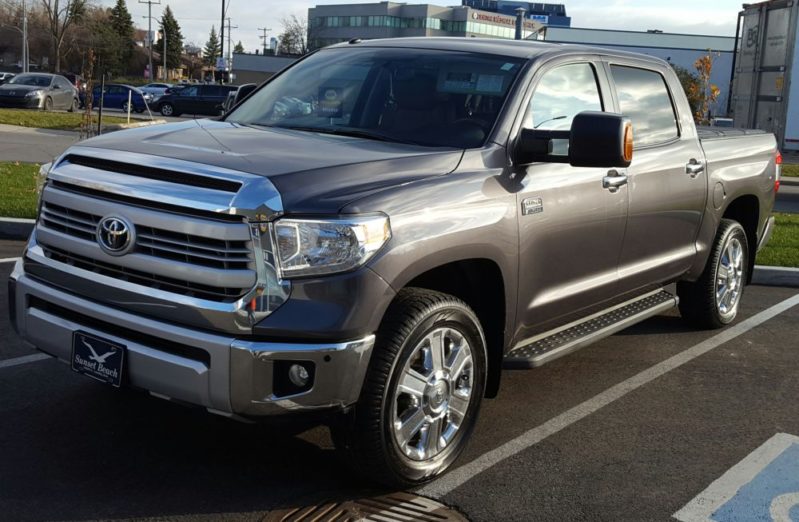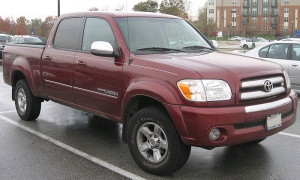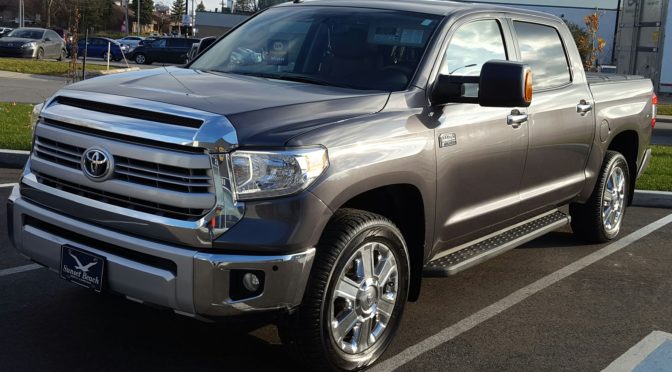The Toyota Tundra is the most-popular non-US-branded large pickup sold in the United States. Interestingly, it’s more domestic than most vehicles in the country, having been assembled in Princeton, Indiana in the past and currently assembled in San Antonio, Texas. It competes with other giant pickups like the Ford F-150, Chevy Silverado, Nissan Titan, and Dodge Ram, and is more reliable than all of them put together. Can you tell I’m a fan?
Because of the rock-solid reliability of the Tundra and its go-anywhere, do-anything reputation, it’s no surprise that a number of parents look to the Tundra to take care of their little ones in terms of day-to-day transportation. As a result, I borrowed a few Tundras to see if they were as up to hauling 3 car seats across the back rows as they were to hauling several thousand pounds of lumber in the bed. The good news is that they were more than up to the task. Before getting into the details, however, let’s take a look at rear-facing, forward-facing, and other suggestions for keeping your kids safe in your Tundra.
For me, everything starts with rear-facing. To keep your infants, toddlers, and preschoolers as safe as possible, I typically suggest keeping children rear-facing as long as possible (until 4 or 5 like the Swedes), followed by harnessing until they can safely use booster seats (until at least 5, like the Swedes), and then boostering until the 5 step test is passed (typically between 10, 11, and 12). Beyond that, I suggest keeping kids in the back seat until at least 13, and delaying teen solo driving until 18 if possible. Even if you’re in a large vehicle, you’ll protect your children far more by properly restraining them than by skipping stages.
Now that’s out of the way, let’s take a look at what worked and what didn’t. The fact of the matter is that with a vehicle as large as the Tundra, you typically aren’t going to have any issues with 3 across car seat installations in terms of width; your main challenges will have to do with front-to-back room, which depends on your cabin sizes. That said, this is likely to be the most thorough 3 across car seat guide for the Toyota Tundra on the Internet, and I’ll keep adding to it over time.
You can access the complete 3 across guide for every vehicle here and the complete list of recommended seats here. The Canadian car seat guide is here. 3 across car seat images are courtesy of Wikipedia.
 2007, 2008, 2009, 2010, 2011, 2012, 2013, 2014, 2015, 2016, 2017, 2018, 2019, 2020 Toyota Tundra (XK50)
2007, 2008, 2009, 2010, 2011, 2012, 2013, 2014, 2015, 2016, 2017, 2018, 2019, 2020 Toyota Tundra (XK50)
Guaranteed 3 across installations:
Clek Fllo (x3).
Clek Foonf (x3).
Diono Radian 3RXT (x3).
Diono Radian 3RX (x3).
Clek Oobr (x3).
Diono Radian RXT (x3).
Diono Radian R120 (x3).
Diono Radian R100 (x3).
Diono Rainier (x3).
Diono Pacifica (x3).
Diono Olympia (x3).
Combi Cocorro (x3).
Chicco KeyFit 30, Britax Pinnacle 90, Clek Foonf.
Clek Fllo, Britax Pinnacle 90, Chicco KeyFit 30.
Clek Foonf, Britax Frontier 90, Chicco KeyFit 30.
Clek Fllo, Britax Frontier 90, Chicco KeyFit 30.
Graco Size4Me 65 (x3).
Graco Contender (x3).
Britax Boulevard ClickTight, Diono Radian / RXT, Britax Frontier G1.1.
Britax Boulevard G4.1, Diono Radian / RXT, Britax Frontier G1.1.
Britax Marathon ClickTight, Diono Radian / RXT, Britax Frontier G1.1.
Britax Marathon G4.1, Diono Radian / RXT, Britax Frontier G1.1.
Britax Boulevard ClickTight, Diono Radian / RXT, Britax Frontier G1.1.
Britax Pavilion G4, Diono Radian / RXT, Britax Frontier G1.1.
Diono Radian / RXT, Chicco KeyFit 30, Graco TurboBooster.
Diono Radian / RXT, Diono Radian / RXT, Graco TurboBooster.
Britax Boulevard ClickTight, Clek Fllo, Britax Frontier G1.1.
Britax Boulevard G4.1, Clek Fllo, Britax Frontier G1.1.
Britax Marathon ClickTight, Clek Fllo, Britax Frontier G1.1.
Britax Marathon G4.1, Clek Fllo, Britax Frontier G1.1.
Britax Boulevard ClickTight, Clek Fllo, Britax Frontier G1.1.
Britax Pavilion G4, Clek Fllo, Britax Frontier G1.1.
Tips and Tricks:
The second generation of the Toyota Tundra is between 209 and 248 inches long, depending on which cab size you choose, and 80 inches wide. Dimension-wise, it’s almost exactly the size of the current F-150. In other words, you’re going to be able to fit just about any 3 car seats next to each other when it comes to width.
However, when it comes to front-to-back space, what you can and can’t do will depend on your cab size. The Tundra comes in a 2-door regular cab, a 4-door double cab, and a 4-door crewmax. The double cab is the replacement of the access cab in the previous generation while the crewmax is the replacement of the double cab in the previous generation.
The crewmax will be the most car seat-friendly, while you won’t be able to fit any car seats anywhere in the regular cab except for in the front passenger seat, and it’ll need to be a front-facing car seat unless you can completely disable the front passenger airbag.
In the current double cab, you might have a good bit of trouble due to needing to choose between car seats and front-passenger space. Shorter car seats like the Fllo and Size4Me 65 will help you make the most of your front-to-back space.
 2000, 2001, 2002, 2003, 2004, 2005, 2006 Toyota Tundra
2000, 2001, 2002, 2003, 2004, 2005, 2006 Toyota Tundra
Guaranteed 3 across installations:
Clek Fllo (x3).
Clek Foonf (x3).
Diono Radian 3RXT (x3).
Diono Radian 3RX (x3).
Clek Oobr (x3).
Diono Radian RXT (x3).
Diono Radian R120 (x3).
Diono Radian R100 (x3).
Graco Size4Me 65 (x3).
Graco Contender (x3).
Combi Cocorro (x3).
Clek Foonf, Britax Frontier G1.1, Chicco KeyFit 30.
Clek Fllo, Britax Frontier G1.1, Chicco KeyFit 30.
Tips and Tricks:
The first generation of the Toyota Tundra is 218 inches long in the 2-door regular cab and 4-door access cab trims and 230 inches long in the 4-door double cab trim. It’s 75 inches wide in the regular and access cabs and 79-80 inches wide in the double cab trims.
What this means is that you’ll be able to fit a whole mess of car seats the double cab trims, but not nearly as many in the regular and access cabs. Additionally, if you’re driving the access cab, you’ll likely have some trouble with front-to-back space unless you’re using shorter car seats. If you’re driving the the regular cab, you’ll be able to fit a front-facing car seat in the passenger seat, but you won’t be able to use a rear-facing seat there unless you can completely disable the passenger airbag.
In the access cab, you might have a good bit of trouble due to needing to choose between car seats and front-passenger space. Shorter car seats like the Fllo and Size4Me 65 will help you make the most of your front-to-back space.
 If you find my information on best practices in car and car seat safety helpful, you can do your shopping through this Amazon link. Canadians can shop here for Canadian purchases. Have a question or want to discuss best practices? Send me an email at carcrashdetective [at] gmail [dot] com.
If you find my information on best practices in car and car seat safety helpful, you can do your shopping through this Amazon link. Canadians can shop here for Canadian purchases. Have a question or want to discuss best practices? Send me an email at carcrashdetective [at] gmail [dot] com.

